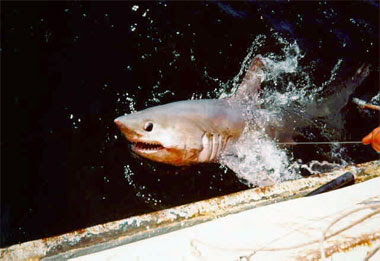This past weekend, a commercial diver off of Eastport, Maine, had a scary and strange encounter with a large shark. Scott MacNichol was videotaping the sea bottom below an empty salmon pen when he saw an 8-foot shark approach and had to eventually fend it off with his camera. He hurriedly returned to his boat. In the mayhem, he shot about 20 seconds of video.

Stills from the 20-second porbeagle shark encounter video. The full video can be viewed on the Bangor Daily News website. (Photo: Mer Assessment Corp.)
The video is not the stuff of shark nature shows, but it offers some clues in identifying the species. Early in the video, you can see a couple of seconds of the shark's full body, which is fairly stout but also has a distinct white patch at the rear base of the dorsal or back fin. This is the key identifying characteristic of a porbeagle shark, which is a cold water shark.

Porbeagle shark rendering (Source: NOAA)
PORBEAGLES: TRUE COLD WATER SHARKS
Above all, we are thankful for the safety of Scott MacNichol. He is remarkably composed and insightful. However, there are a number of unusual aspects of this story. Shark encounters are very uncommon in New England but even more so for Maine. Despite its spectacular coastline, shark densities are fairly low there. The most common sharks seen there are blue sharks, seen mostly in the summer, filter-feeding basking sharks and porbeagles.
Porbeagles are truly a cold water shark as they have the ability to maintain a core body temperature many degrees above the surrounding water temperature. That is an unusual physiological capability for a shark. Most shark species visiting New England migrate south as the water cools. Porbeagles actually do not like warm water. Their primary habitat is off the Maritime Provinces of Canada and the cooler waters of New England.
PORBEAGLES ALMOST NEVER HAVE ENCOUNTERS WITH PEOPLE
Porbeagles' main diet is herring, mackerel and other schooling fish. Humans are not on their menu, but any large shark can be dangerous. The International Shark Attack Files (ISAF) based out of the Florida Museum of Natural History, collects data from around the world on human/shark incidents.

Porbeagle population distribution map (Florida Museum of Natural History)
ISAF records show that despite the porbeagle's distribution around the cooler waters of the world, there have only been two recorded incidents and interestingly enough, both involve divers in non-fatal encounters in Canada and off of Great Britain. One of those incidents happened in Nova Scotia in 2000 when a diver collecting sea urchins had his harvest bag grabbed by a porbeagle while his hand was still entangled. Their several minute struggle is described on a website about sharks in New England that is maintained by Captain Tom King, a charter boat fisherman out of Scituate. The website is well regarded by biologists, although the squeamish should be advised that it is a fishing website and has many images of landed sharks that are dead. Here's the link.
TRYING TO EXPLAIN THE SHARK'S BEHAVIOR
Explaining the shark's behavior is difficult and at best, informed conjecture. Commercial divers in Maine do see porbeagles and very rarely have a problem. People are way off the size scale of these sharks' normal prey items, and most wildlife have a very clear instinct that human beings can be dangerous to them.

Porbeagles consume groundfish such as flounders (Florida Museum of Natural History)
The diver's colleague speculated that the electronic signal created by the video camera and its flashy metal casing might have confused the shark as to whether the camera was a fish in distress. Sharks, unlike human beings and most other fish species, truly have a sixth sense called electroreception. Sharks have sensory organs that allow them to detect low-frequency electrical fields. This helps them hunt in low light or detect prey items buried in the sand.
The porbeagles in the Nova Scotia and Maine incident reports displayed a common behavior: appearing to be interested in what was in the diver's hand--a sea urchin harvest bag and the camera, possible food items. Divers are often advised to give up perceived food items and to minimize the amount of shininess on any gear so as to reduce the chance of it reflecting light the way that fish scales do. In both of these situations, the divers handled themselves very well. For a comprehensive description of what divers should do around sharks visit the ISAF divers tips page.
PORBEAGLE POPULATIONS HAVE DROPPED DRAMATICALLY
Porbeagles are a much more rare sight than they were once were. Greg Skomal, Massachusetts shark biologist, noted in his new book, The Shark Handbook, that Norwegian fisherman targeted the porbeagle population off the North American East Coast in the 1960s, catching up to 18 million pounds per year or 90,000 sharks annually. As is to be expected, the population crashed, and commercial fishing was no longer viable.

Porbeagle shark being caught (Photo: NOAA)
The recovery of a shark population can take much longer than that of most other fish species. Most shark species become sexually mature at much older ages and then have only a few live young born each year versus thousands of eggs dispatched by many other fish species. Overharvested shark populations can take decades to recover. Porbeagles are listed on a global level as vulnerable, and Skomal estimates that the regional porbeagle population is about one tenth of its peak size. There is a still commercial harvest of porbeagles in Canada, and porbeagles are a prized target of recreational and charter shark fishermen in U. S. waters.
-Tony

















